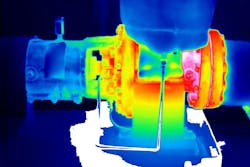Troubleshooting motors and drives
Motors play a crucial role in every industry — and with the rise of automation, they are likely to become more important than ever. By the same token, motor failure can spell catastrophe for processing plants, leading to costly downtime, high maintenance costs and a drop in productivity.
Today’s motors are highly complex, as are the assets they power. Maintaining them at peak performance can be a challenge. However, with the augmentation of tools through software, cloud and artificial intelligence (AI), crews can successfully streamline workflows, stay ahead of unexpected failures, improve performance and extend motor lifespans.
This article outlines some of the best ways to troubleshoot motors and drives, as well as discussing long-term solutions for extending motor lifespans.
What makes a motor fail?
To put it simply: motors can fail due to electrical issues or mechanical problems. Excess wear and tear on bearings (a mechanical problem) can cause motor failure. So can winding insulation breakdown. Most motor issues fall into those two buckets.
Of course, there are many different factors behind bearing failure and insulation breakdown. Let’s take a look at some of the most common factors behind both — and then we’ll talk about how to fix them.
Overheating
Almost a third (30%) of motor failures are caused by overheating, so it is hard to overstate the importance of this one. Overheating causes premature wear on both the electrical and mechanical components of a motor, leading to motor failure.
The good news? A reliable thermal camera can capture the earliest signs of overheating, so that crews can investigate and make repairs long before a motor fails. And we will also talk about how proactive maintenance strategies can help teams stay ahead of shutdowns.
Electrical issues
Transient voltage — sudden, sharp changes in voltage levels — can cause damage to a motor’s winding insulation. Over time, that damage can create unexpected motor failure, taking a plant off-line.
Tracking the cause of transients can be a challenge. They can be caused by nearby loads turning on and off, by an issue in capacitator banks or even by the weather.
Voltage imbalances can also contribute to winding insulation breakdown. Even relatively minor imbalances can place undue stress on the motor’s phase circuits, leading to excessive current flow and high enough temperatures to damage the motor insulation.
Harmonic distortions, variable frequency drives and sigma currents can all contribute to excess wear and tear on the winding insulation as well.
The solution? A well-designed power quality and motor analyzer can measure voltage and current, as well as harmonic distortions. The best tools can also spot power quality issues like transients, imbalance and dips or swells in power levels — so you can see trouble coming and get ahead of it.
Mechanical issues
Premature wear and tear on a motor’s mechanical drive components can lead to permanent motor failure. There are a few key factors that can bring this about.
Shaft misalignment causes excess vibration levels throughout the machine, but especially in the motor drive shaft. Over time, this causes enough wear and tear to permanently bring down your motor.
Pipe strain — the result of excess force applied to pipeworks, often as the result of an incorrectly installed component — can make misalignment more severe. Pipe strain increases the stress on rotating components and can damage your motors.
Soft foot, often caused by pipe strain, can also cause premature bearing failure, leading to motor failure. Soft foot can cause misalignment or make existing misalignment worse. This can result in excess fuel consumption and eventually motor failure.
The fix: a good laser alignment tool can identify and correct misalignment. The best laser alignment tools take fast, accurate measurements even in harsh environments, so factors such as high temperatures or vibration levels will not get in the way. Look for tools designed to be user-friendly and easy to learn.
Shaft imbalance and looseness can also cause premature wear and tear on mechanical drive components, leading to motor failure. And factors like excess load and inadequate lubrication can lead to premature wear on bearings, contributing to early motor failure.
The fix: vibration testing is one of the best ways to identify unbalance, looseness and bearing wear. Using a vibration monitor or a wireless sensor allows teams to catch potential issues and nip them in the bud.
Staying ahead of trouble with a proactive maintenance approach
When something is important — such as the motors powering a processing plant — take every possible precaution to keep it safe.
Proactive maintenance is the best way to keep motors and drives at peak performance levels. Instead of the older reactive maintenance approach, proactive maintenance keeps crews a few steps ahead of trouble, reducing unplanned downtime and maintenance costs.
Preventive maintenance
Preventive maintenance, or calendar-based maintenance, might mean routine inspections and cleanings, checking and tightening components, and checking power quality.
Building a preventive maintenance program can go a long way to extend your motor lifespans — especially if you track your preventive maintenance completion rate on a CMMS.
Predictive maintenance
Predictive maintenance does even more to boost reliability in a processing plant. Predictive maintenance uses a network of cloud-connected sensors to track asset health in real-time. AI-powered data analytic software can sift through the metrics and alert operators to any signs of trouble right away.
Done right, predictive maintenance lets operators see exactly what a plant’s motors need to stay healthy — so that teams can perform the maintenance tasks they need. By tracking and trending vibration levels, temperature and power quality, facilities can stay ahead of motor failure.
Building a connected reliability solution
Most successful plants do not adopt just one maintenance strategy. Typically, teams use a mixture of approaches so they can tailor maintenance plans to their budget and their production goals.
A connected reliability solution ties together the different pieces of a maintenance program, so that teams can easily see the big picture — and the details — at once.
Connected reliability means that all systems, tools and personnel can share data and communicate ideas easily. Condition monitoring sensors stream asset health data to a central location, so that maintenance crews can easily access work order data. Cloud connectivity makes it easy to share data with decision makers who aren’t on-site. And data analytics lets you track and trend asset health so you can stay ahead of potential problems.
The result? A streamlined, efficient way to keep motors and drives at peak performance for longer, reducing unplanned downtime and cutting costs. And that is a worthwhile goal for any organization.
Michael Crepps, Fluke Application Specialist, joined Fluke in 2016 as a Technical Support Engineer. Michael has been providing support and training on electrical test and measurement tools for the past 7 years. Prior to Fluke, Michael worked in the bio-tech industry providing technical expertise in manufacturing and development.
About the Author
Michael Crepps
Fluke Application Specialist
Michael Crepps, Fluke Application Specialist, joined Fluke in 2016 as a Technical Support Engineer. Michael has been providing support and training on electrical test and measurement tools for the past 7 years. Prior to Fluke, Michael worked in the bio-tech industry providing technical expertise in manufacturing and development.


